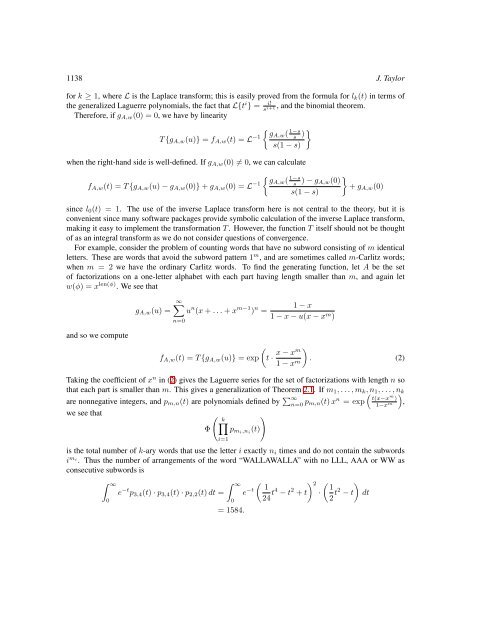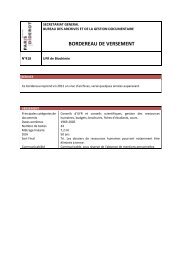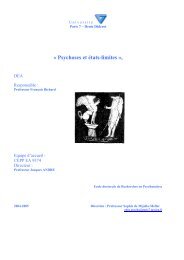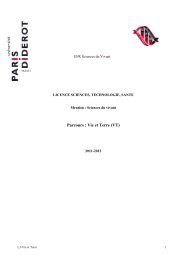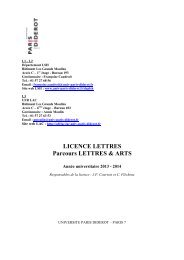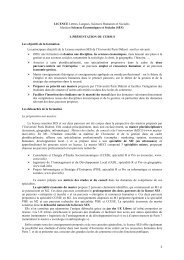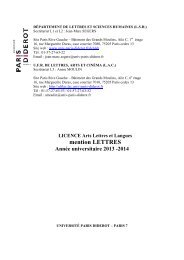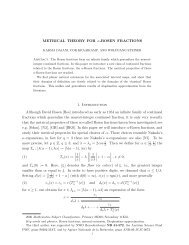Counting words with Laguerre polynomials - liafa
Counting words with Laguerre polynomials - liafa
Counting words with Laguerre polynomials - liafa
Create successful ePaper yourself
Turn your PDF publications into a flip-book with our unique Google optimized e-Paper software.
1138 J. Taylor<br />
for k ≥ 1, where L is the Laplace transform; this is easily proved from the formula for l k (t) in terms of<br />
the generalized <strong>Laguerre</strong> <strong>polynomials</strong>, the fact that L{t i } = i!<br />
s<br />
, and the binomial theorem.<br />
i+1<br />
Therefore, if g A,w (0) = 0, we have by linearity<br />
s )<br />
T {g A,w (u)} = f A,w (t) = L −1 {<br />
gA,w ( 1−s<br />
s(1 − s)<br />
when the right-hand side is well-defined. If g A,w (0) ≠ 0, we can calculate<br />
{<br />
f A,w (t) = T {g A,w (u) − g A,w (0)} + g A,w (0) = L −1 gA,w ( 1−s<br />
s<br />
s(1 − s)<br />
}<br />
) − g A,w(0)<br />
}<br />
+ g A,w (0)<br />
since l 0 (t) = 1. The use of the inverse Laplace transform here is not central to the theory, but it is<br />
convenient since many software packages provide symbolic calculation of the inverse Laplace transform,<br />
making it easy to implement the transformation T . However, the function T itself should not be thought<br />
of as an integral transform as we do not consider questions of convergence.<br />
For example, consider the problem of counting <strong>words</strong> that have no subword consisting of m identical<br />
letters. These are <strong>words</strong> that avoid the subword pattern 1 m , and are sometimes called m-Carlitz <strong>words</strong>;<br />
when m = 2 we have the ordinary Carlitz <strong>words</strong>. To find the generating function, let A be the set<br />
of factorizations on a one-letter alphabet <strong>with</strong> each part having length smaller than m, and again let<br />
w(φ) = x len(φ) . We see that<br />
g A,w (u) =<br />
∞∑<br />
u n (x + . . . + x m−1 ) n 1 − x<br />
=<br />
1 − x − u(x − x m )<br />
n=0<br />
and so we compute<br />
f A,w (t) = T {g A,w (u)} = exp<br />
(t · x − )<br />
xm<br />
1 − x m . (2)<br />
Taking the coefficient of x n in (2) gives the <strong>Laguerre</strong> series for the set of factorizations <strong>with</strong> length n so<br />
that each part is smaller than m. This gives a generalization of Theorem 2.1. If m 1 , . . . , m k , n 1 , . . . , n k<br />
are nonnegative integers, and p m,n (t) are <strong>polynomials</strong> defined by ∑ (<br />
∞<br />
n=0 p m,n(t) x n = exp t(x−x m )<br />
1−x<br />
), m<br />
we see that<br />
( k<br />
)<br />
∏<br />
Φ p mi,n i<br />
(t)<br />
i=1<br />
is the total number of k-ary <strong>words</strong> that use the letter i exactly n i times and do not contain the sub<strong>words</strong><br />
i mi . Thus the number of arrangements of the word “WALLAWALLA” <strong>with</strong> no LLL, AAA or WW as<br />
consecutive sub<strong>words</strong> is<br />
∫ ∞<br />
∫ ∞<br />
( ) 2 ( 1<br />
1<br />
e −t p 3,4 (t) · p 3,4 (t) · p 2,2 (t) dt = e −t 24 t4 − t 2 + t ·<br />
2 t2 − t)<br />
dt<br />
0<br />
0<br />
= 1584.


